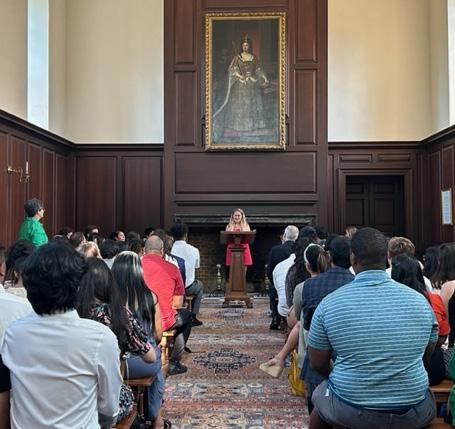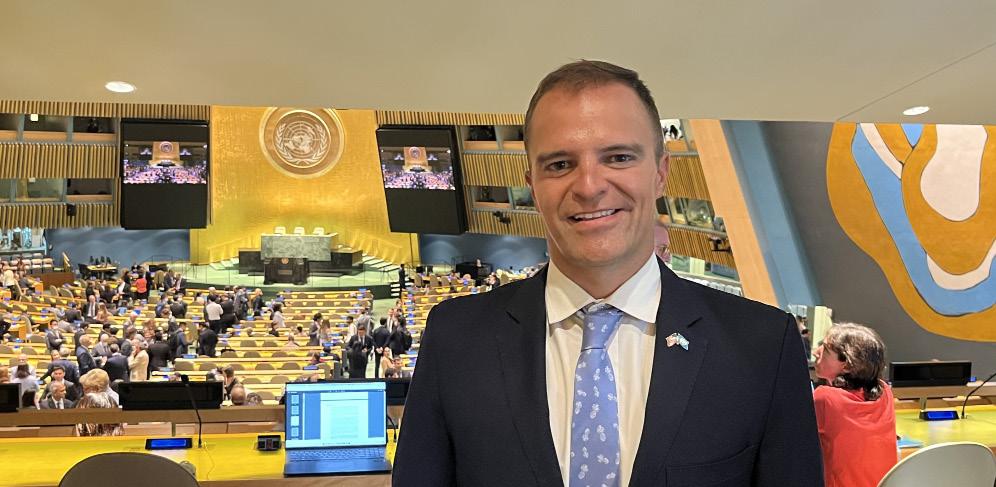
8 minute read
First Baptist Church Excavation project reveals genetic link to church community
are closely associated with.”
Thursday, April 6, archaeologists working on the First Baptist Church Excavation project in Colonial Williamsburg presented their findings on burial sites and human remains found on the grounds of the original First Baptist Church in 2021 at the Williamsburg Stryker Center.
Colonial Williamsburg, the First Baptist Church and Let Freedom Ring Foundation partnered with the Jamestown Rediscovery Foundation in May of 2020 to “conduct ground-penetrating radar,” according to the project’s website. Initial results concluded that the original First Baptist Church site, founded by free and enslaved Black men and women at the start of the American Revolution, had been covered by a parking lot on South Nassau Street in Colonial Williamsburg.
Over the next few years, an excavation project revealed the original foundation of the church as well as evidence of burial sites on the property. In February 2021, members of the First Baptist Church congregation met to agree on the next phase of the project, ultimately deciding to excavate the deceased in order to learn about their identities and properly honor their memory. In July 2022, archaeologists began their excavation of the burial sites and presented their findings to the community at the start of April.
“The First Baptist Church was organized in 1776 by enslaved and free Black people in defiance of laws of the day forbidding the congregation of African Americans,” the Colonial Williamsburg Foundation said a press release.
The physical church site, built in 1856, was purchased by Colonial Williamsburg in 1956 and torn down, with the payment for the land then used to construct the second iteration of the First Baptist Church on Scotland Street.
Member of the First Baptist Church and President of the Let Freedom Ring Foundation Connie Matthews Harshaw spoke about the initial goals of the excavation project.
“The Let Freedom Ring Foundation is a 501(c)(3) nonprofit, we are associated with the historic First Baptist Church, and we are directly responsible for protecting and preserving the historic building and landscape and collecting and preserving artifacts,” Harshaw said. “I say that because we were looking for artifacts on the original site of the First Baptist Church when we met with CW in March of 2020, and we thought if we could just find some of the artifacts on the original site, that would be great.”
Since the initial excavation began, experts from the College of William and Mary, the University of Connecticut and Colonial Williamsburg have completed DNA, osteological and archeological studies of the bodies buried on the site of the original church. Their findings have now proven
I Love Every Aspect of my Semester Abroad
Ellie Kurlander ‘24 argues that studying abroad is best when you go into it with an open mind and realistic expectations page 5 that the individuals buried on the site are of African descent and many are believed to have constructed the original 1856 church building. Out of 63 confirmed burials, Colonial Williamsburg decided to test the extent of preservation on three deceased individuals.
National Science Foundation postdoctoral fellow at the University of Connecticut Raquel Fleskes aided with the osteological and DNA analysis of the exhumed remains.
“The Virginia area has very high clay soils that are very acidic and very wet, and so those three factors usually lead to poor preservation of human remains,” Fleskes said. “We wanted to make sure that we weren’t going to be uncovering these graves unnecessarily.”
According to Fleskes, out of the three burials tested, burial No. 26 was the best preserved, potentially due to the location of his body which excavators found underneath the foundation of one of the church buildings.
“With burial No. 26, we were able to generate really good DNA data — this individual is male, he has an X and Y chromosome and he is of African descent,” Fleskes said. “These findings are really important because it provides the only definitive estimation of the ancestry of these burials. Because the osteological remains were very poor, they could only very tangentially estimate ancestry affiliation. So the DNA provides that concrete estimate of what population [these individuals]
Harshaw emphasized the importance of the input from descendent community members, and the significance of the accomplishments on the property since 2020.
“America has heard the story told by others for a very long time,” Harshaw said. “This is the descendants’ story, and they must have a voice. They must make the decisions about what happens on that site, they must make a decision about anything that’s found on that site. And this was before we knew about intact burials – we needed to make sure we had 100% community and descendent engagement.”
Harshaw mentioned that the team working on this project and partners at the College’s Institute of Historic Biology will be recognized this fall as one of the most successful community engagement efforts currently going on in the United States.
“It is, right now, considered to be the most historically significant archaeological project in the country,” Harshaw said. “It was a challenge at first because we had to rebuild trust in the community in Colonial Williamsburg and also the other partners in the community because of the treatment they received during the Jim Crow era. A lot of the descendants that were here then are still alive, so I have to tell you that we have made remarkable progress in improving those relations.”
Flat
College releases Class of 2027 decisions, reports 32% acceptance rate
Friday, March 24, the College of William and Mary released regular decision results to prospective studentsʼ applicant portals. The College received over 17,500 applications this year with an 18% increase in Early Decision applicants, making for a total of over 1,400 applications across Early Decision I and II. Admission for Early Decision applicants increased 10% from last yearʼs class, with over 600 students offered admission through this process.
Compared to a 33% overall admission rate for the Class of 2026, 32% of applicants gained acceptance into the Class of 2027. The College expects to welcome around 1,650 students this fall, 40% of which identify as students of color and 6% of which are international students. After the College announced on March 2, 2023 that it would extend its testoptional admission process indefinitely, around 30% of this yearʼs applicants applied without standardized test scores.
Student Assembly president Sydney Thayer ʼ24 expressed her excitement following the admissions decisions in March.
“With each new class of W&M students brings a whole new set of diverse experiences, interests and perspectives that allow our community to learn and grow,” Thayer wrote in an email. “We are so excited to hear their fresh perspectives and hope to do everything we can to support them as they find their community, explore their passions, and kick off their time here at W&M!”
The College hosted its You Belong event on April 14 and Day for Admitted Students (DFAS) on April 15, 2023.

College alumni S. Douglas Bunch ʼ02, J.D. ʼ06 emphasizes education, professional achievements
JOSEPH WEHMEYER // FLAT HAT NEWS ASSOC.
After graduating from the College of William and Mary, Board of Visitors member S. Douglas Bunch ’02, J.D. ’06 still centers education within his career. Whether working as a partner at Cohen Milstein Sellers and Toll PLLC or as a U.S. representative at the United Nations, Bunch continues to emphasize the importance of learning.
“I think education may be the number one factor in advancement and mobility, socially, economically, in terms of the progress of humankind in general,” Bunch said. “I think it’s the way that we can do the most to improve our own ability to help the rest of the world and advance our common interests as human beings.”
Bunch’s desire to improve opportunities for others is rooted in his personal experiences.
“I grew up in Augusta County, Virginia,” he said. “My dad drove a UPS truck and my mom was a public school teacher. I was the first person on my dad’s side of the family to graduate from college. For me, William and Mary was truly transformative. It inspired me to think critically, creatively and globally.”
When investing in the education of others, Bunch thinks big and does not shy away from ambitious projects.
As a Monroe Scholar in 2000, he founded Ascanius: The Youth Classics Institute, a nonprofit organization which teaches classical studies to elementary and middle school students. In 2006, Bunch co-founded Global Playground, a nonprofit which has built educational infrastructure in 11 underdeveloped and developing countries.
“We run Global Playground on less than $75,000 per year,” Bunch said. “That allows us to build roughly a project a year. Normally classrooms or sometimes an entire school, sometimes a community center or a library… We’ve had a huge impact with a very small investment, and that’s been really fulfilling to see.”
Global Playground hosts students from the College participating in Freeman Intern Fellowships in East Asia. Starting in 2018, the Charles Center for Academic Excellence began sponsoring unpaid internships in the region.
“Both last summer and this coming summer there will be Freeman Fellows from William and Mary who are residents at our school in Northern Thailand,” Bunch said. “That alone has a significant impact.”
In 2022, President Joe Biden appointed Bunch as a public delegate of the United States to the 77th session
Academics
of the U.N. General Assembly. In this role, he has made several statements in the UNGA Third Committee, which addresses social, humanitarian and cultural issues.

In this role, Bunch organized a consortium of colleges and universities to regularly engage with the U.S. mission at the U.N. According to Bunch, the U.N. hosts monthly briefings on “significant issues of mutual interest,” such as climate change, the one year anniversary of Russia’s aggression in Ukraine, water and food insecurity.
“It’s been a privilege to be at the table and in the room when we advance U.S. policy interests, which very often are the policy interests across many other member states,” Bunch said.
Governor Terry McAuliffe appointed Bunch to the College’s BOV in 2016, and he was reappointed by Governor Ralph Northam in 2020. As a member of the BOV, Bunch has a say in critical decisions at the College, including choices regarding tuition rates, granting tenure and hiring the College’s president.
“We also set the vision and mission of the institution,” Bunch said. “We’re a constant sounding board for the president a nd other senior staff as they make important decisions.”
Bunch’s engagement with the College is extensive. As an undergraduate, he was an aide to former College President Timothy J. Sullivan. Bunch also received the inaugural W. Taylor Reveley Award in 2011, recognizing his commitment to public service, and spoke at the College’s first Lavender Graduation ceremony in 2018, celebrating the achievements of its LGBTQ+ graduates.
“The institution has progressed far beyond where it was when I arrived in 1998 but also when I graduated in 2002,” Bunch said. “We’re far more diverse, inclusive, [and] forward looking… [We’re] demonstrating to the rest of the world what a special place we are. A place that truly values undergraduate research. Where community means something. Where people have each other’s backs. Where the alumni community is strong and loyal. Where there’s a focus on development of your entire self as an undergraduate.”
Bunch attributes his experiences and perspective gained as an undergraduate at the College for his achievements as a lawyer and diplomat. He spoke optimistically about the College’s current state and its future.
“We’re in a really special place as an institution,” Bunch said. “President Rowe has been fearless in her leadership and bold in all the ways we needed. Entrepreneurial in ways that we asked her to be. She’s truly taken us to the next level and then some. We’re heading towards an exciting place.”

